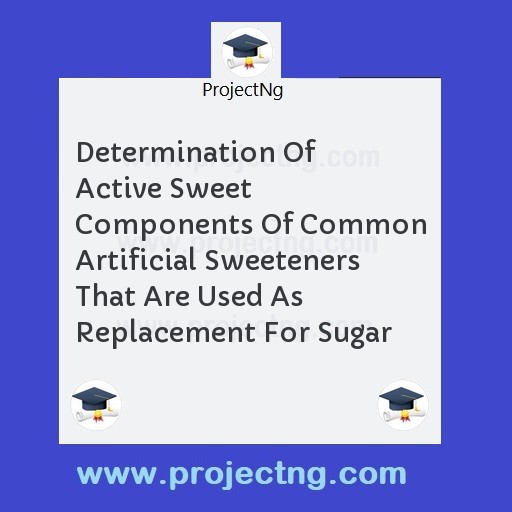Determination Of Active Sweet Components Of Common Artificial Sweeteners That Are Used As Replacement For Sugar
Bio-chemistry Project Topics
Get the Complete Project Materials Now! »
ABSTRACT
This research investigated how the sweetness of sugar substitute compares to the sweetness of sugar. In this research different percentage solution of sugar, artificial sweetener and natural sweetener (10%, 1%, 0.1% and 0.01%) were prepared. Ten volunteers were gathered for the sensory evaluation in this case tasting of the solution, the volunteer‟s taste threshold of data was gotten. The artificial sweetener was found out to be the sweetest among the substances experimented and at the percentage of 0.1% and 0.01% saccharin an artificial sweetener was able to mimic the taste of sugar. Research prove that artificial sweetener are non-nutritive they have virtually no calories in contrast to sugar which contains 4 calories at each gram, a teaspoon of sugar is about 4 grams, for weight lose artificial sweetener may be an attractive option to sugar. Artificial sweetener may also be a good alternative for diabetic patient, unlike sugar; artificial sweeteners generally don‟t raise blood sugar levels because they are not carbohydrates.
TABLE OF CONTENTS
Title page -----------------------------------------------------------------------------i
Certification-------------------------------------------------------------------------ii
Acknowledgement-----------------------------------------------------------------iii
Abstract-------------------------------------------------------------------------------iv
Table of contents--------------------------------------------------------------------v
CHAPTER ONE
1.0 Introduction---------------------------------------------------------------------1-4
1.1Research aim and objectives--------------------------------------------------4-5
1.2 Significance of study...........................................................................5
CHAPTER TWO
Review of literature
2.0 Table sugar (sucrose).........................................................................6
2.1Classification of sugar........................................................................6-7
2.1.1Mechanism of action in the body....................................................7-8
2.1.2 Sugar alcohols and novel sweeteners.............................................8-9
2.1.3 Advantages and disadvantages of sugar........................................9-10
2.2 Artificial sweetener...........................................................................10-11
2.2.1 Advantages and disadvantages of artificial sweetener...................11-12
2.2.2 Reasons for use...............................................................................12-13
2.2.3 Differences btw sugar and artificial sweetener..............................13
2.2.4 Biochemical reaction of artificial sweetener..................................13
2.3 Aspartame..........................................................................................15-16
2.4 Sucralose.....................................................................................17
2.5 Saccharin.....................................................................................18-19
2.6 Stevia...........................................................................................19-20
2.7 Erythritol......................................................................................20-21
2.8 Honey...........................................................................................21-22
CHAPTER THREE
3.0 Materials and methods................................................................23
3.1 Equipment/apparatus used...........................................................23
3.2 Methodology................................................................................24-25
3.3 Testing the solutions.......................................................................27-28
CHAPTER FOUR
4.0 Result.............................................................................................29
4.1 Volunteer‟s taste threshold data for sugar.......................................30
4.2 Volunteer‟s taste threshold data for saccharin................................31
4.3 Volunteer‟s taste threshold data for honey......................................31
4.4Total number of people who detected a change in taste..................32
4.5 Degree of sweetness........................................................................34
CHAPTER FIVE
Discussion and conclusion....................................................................36-37
References..............................................................................................39
Appendix.................................................................................................46
List of tables
Table 4.1................................................................................................29
Table 4.2................................................................................................30
Table 4.3.................................................................................................31
Table 4.4.................................................................................................32
Table 4.5.................................................................................................34-35
CHAPTER ONE
1.0 INTRODUCTION:
A sugar substitute is a food additive that duplicates the effect of sugar in taste, usually with less food energy. Some sugar substitutes are natural and some are synthetic. Those that are not natural are in general, called artificial sweeteners. Artificial sweeteners and other sugar substitutes are found in a variety of food and beverages marketed as sugar free or diet including soft drinks, chewing gum, jellies, baked goods, candy, fruit juice and ice-cream and yoghurt. [Whitney 2011]
People may not all like the same kind of baked treats but one thing we all agree on is that baked treats should be sweets usually, sugar is used to lend sweetness to foods but would cake taste just as good if the baker used a sugar substitutes instead of sugar? Many people prefer not to use sugar often due to health reasons and instead depend on sugar substitutes to sweeten their foods. But are sugar substitutes the same as sugar? What exactly are the differences between sugar and sugar substitutes?
Sugar also known as sucrose comes from plants like sugar cane and sugar beets and is a carbohydrate. Sugar adds bulk to cakes, cookies and all kinds of treats; sugar also causes browning and caramelizing in foods when it is
heated as when cookies turn golden brown in the oven sugar is a natural substance, something that our bodies can use for energy.
Sugar substitutes come in three categories; artificial sweeteners, sugar alcohols and natural sweeteners. Artificialsweeteners are attractive because they add almost no calories to foods and are sometimes a part of weight loss programs. Also they donot increase blood sugar levels which mean that diabetics can use them. Many artificial sweeteners like sucralose were discovered by accident in the laboratory. In 1976, a scientist in England was studying different compounds made from sugar. The scientist asked a student to test the compounds but instead the student tested them. Another category of sugar substitutes is sugar alcohols. Sugar alcohols are not alcoholic beverages they do not contain ethanol which is found in alcoholic beverages. Sugar alcohols like sugar have calories and energy but not asmuch as sugar. Sugar alcohols like artificial sweeteners do not contribute to tooth decay and affect blood sugar levels slowly so diabetics can use them. Although sugar alcohols like xylitol, sorbitol and erythritol are manufactured products the sources are often natural.
Be the First to Share On Social

Enjoying our content?
Don't miss out on new videos! Subscribe to our YouTube channel for more awesome content.
Subscribe Now!













